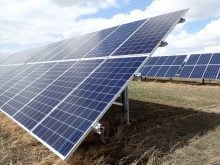The African sun glints off the sleek cows as they stand up to their bellies in lush green grass. The herd of 40, just hand milked by five dairymen, has been let out to pasture for the night. Nearby, the palm trees and rose garden, brought from South Africa, frame the beautifully landscaped farmyard.
At Kamfinsa Dairy Farm, we find the owner, Eugene Meintjes, giving instructions to his workers who are covering the silage pile. They have just chopped five hectares (12.35 acres) of corn, which will be used to feed the cows during the dry season. The Africans are shoveling dirt on the black plastic, and will top that with grass and more dirt. Eugene wishes they had access to the wide silage plastic our Canadian counterparts use. 
Read Also

Farmer ownership cannot be seen as a guarantee for success
It’s a powerful movement when people band together to form co-ops and credit unions, but member ownership is no guarantee of success.
Eugene and his wife, Marleen, and three children relocated to Zambia in 1994, the same year apartheid ended in South Africa. Ongoing drought in their area prompted the move. Eugene’s grandfather was a British soldier in the Second World War, and like so many others, was offered farmland if he stayed in Africa.
He went to the Congo, where he hunted elephants, worked in the mines and began to farm. When Belgium gave Congo its independence in 1962, the family moved first to Zimbabwe and then on to South Africa, where they farmed successfully for many years.
Of the 150 hectares (370 acres) owned by the Meintjes, only about half is arable. Fifteen hectares (37 acres) are in corn and the rest is pasture or hay land. They also keep 100 ewes and some pigs. All of the animals are processed in the farm’s butcher shop. A sign along the main highway advertises ‘Biltong’ or African jerky, and ‘Boerworst,’ a South African specialty sausage.
The dairy herd still shows the Jersey heritage and Brahman bull from many years ago, even though Eugene now uses semen from Canadian Holstein bulls. His best cows milk 25 litres per day, with an average of 15 per day. The milk, sold privately for 4,500 kwachas per litre, or $1.20 Cdn, and is delivered daily to customers, mostly Indians who prefer unpasteurized milk for fermented dairy products.
His cows have little disease, and practically no mastitis, which he attributes to the hand milking. The skin problems caused by ticks and insects are treated by dipping all cattle weekly.
Labour is plentiful and cheap, so much of the work is done manually. With 25 African workers, the Meintjes are responsible for more than 100 people. They provide housing for almost all staff, and also cover medical costs, and help with some school fees for the children. It’s a little like operating your own village. 
When asked how things are going, Eugene replies, “not bad. No power and lots of theft, but not bad at all.” Almost daily power outages, due to shortages in the whole country, have made it costly to run the milk and butchery coolers. Theft is expensive too. Eugene tells us that around every farm there is a group of people that live off it through thievery. Theft is a legitimate expense item. There is a column for it on the government income tax forms.
The Meintjes are happy to be in Zambia. It is a peaceful country and they feel much safer here than in South Africa. Marleen maintains this is no country for sissies, but for them it has become a good place to be.
Previous entries
Diaries of a Global Farmer – March 6, 2008
Diaries of a Global Farmer – February 28, 2008
Diaries of a Global Farmer – February 21, 2008
Diaries of a Global Farmer – February 14, 2008
Diaries of a Global Farmer – February 7, 2008
Diaries of a Global Farmer – February 1, 2008














